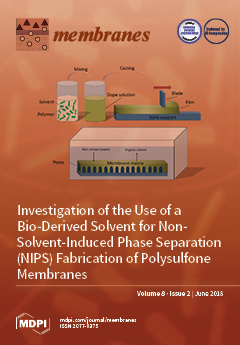In this article, we studied two different types of polyhedral oligomeric silsesquioxanes (POSS
®) functionalized nanoparticles as additives for nanocomposite membranes for CO
2 separation. One with amidine functionalization (Amidino POSS
®) and the second with amine and lactamide groups functionalization
[...] Read more.
In this article, we studied two different types of polyhedral oligomeric silsesquioxanes (POSS
®) functionalized nanoparticles as additives for nanocomposite membranes for CO
2 separation. One with amidine functionalization (Amidino POSS
®) and the second with amine and lactamide groups functionalization (Lactamide POSS
®). Composite membranes were produced by casting a polyvinyl alcohol (PVA) layer, containing either amidine or lactamide functionalized POSS
® nanoparticles, on a polysulfone (PSf) porous support. FTIR characterization shows a good compatibility between the nanoparticles and the polymer. Differential scanning calorimetry (DSC) and the dynamic mechanical analysis (DMA) show an increment of the crystalline regions. Both the degree of crystallinity (
) and the alpha star transition, associated with the slippage between crystallites, increase with the content of nanoparticles in the PVA selective layer. These crystalline regions were affected by the conformation of the polymer chains, decreasing the gas separation performance. Moreover, lactamide POSS
® shows a higher interaction with PVA, inducing lower values in the CO
2 flux. We have concluded that the interaction of the POSS
® nanoparticles increased the crystallinity of the composite membranes, thereby playing an important role in the gas separation performance. Moreover, these nanocomposite membranes did not show separation according to a facilitated transport mechanism as expected, based on their functionalized amino-groups, thus, solution-diffusion was the main mechanism responsible for the transport phenomena.
Full article






